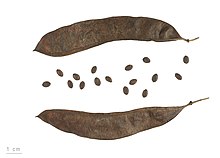bio.wikisort.org - Plant
Cercis siliquastrum, commonly known as the Judas tree or Judas-tree,[1] is a small deciduous tree in the flowering plant family Fabaceae which is noted for its prolific display of deep pink flowers in spring. It is native to Southern Europe and Western Asia.
Description



This species forms a small tree up to 12 m (39 ft) in height and 10 m (32 ft) in width.[2]
The deep pink flowers are produced on year-old or older growth, including the trunk, in spring. Also, the flowers display a blossom with five free petals and fused sepals. This flower shape is typical of the pea family (Fabaceae). The leaves appear shortly after the first flowers emerge. These are cordate with a blunt apex, which occasionally has a shallow notch at the tip. The tree produces long flat pods that hang vertically. The flowers are edible and reportedly have a sweet-acid taste.[2]
Taxonomy

The species was first described by Linnaeus in 1753 and he gave it the specific epithet of siliquastrum which is derived from the Latin word siliqua, meaning "pod".[3] The generic name comes from the Greek kerkis, a "shuttle", which refers to the resemblance shown to this weaver's tool by the flat, woody seedpods.[4]
There are several varieties and subspecies including:-
- var. hebecarpa Bornm.
- nothosubsp. yaltikirii (Ponert) Govaerts
- var. siliquastrum
- var. alba Weston
Distribution and ecological aspects





The flowers are pollinated by bees, attracted by nectar. Pollen from the protruding stamens is deposited on the bee's body and carried to another flower's stigma.[5]
In Israel the tree has a status of a protected plant.
British journalist Francis McCullagh reported seeing "innumerable" flowering specimens of this tree in Yildiz Park in Istanbul in April 1909.[6]
Cultivation
The species prefers deep, well-drained soils and a position in full sun or partial shade.[2]
Cultivars include:
- 'Afghan Deep Purple'[7]
- 'Alba' - white flowers[7]
- 'Bodnant'[7]
- 'Carnea'[7]
- 'Fructa Rubra'[7]
- 'Penduliflora'[7]
- 'Rubra' - dark pink-purple flowers
- 'Sterilis'[7]
- 'Variegata'[7]
- 'White Swan'[7]
The cultivar 'Bodnant' has gained the Royal Horticultural Society's Award of Garden Merit.[8] (confirmed 2017).[9]
The tree is susceptible to leafhoppers, scale insects and psyllids (specifically Cacopsylla pulchella) as well as diseases including canker, coral spot and verticillium wilt.
Propagation is by seed, cuttings or budding.
The species produces hard wood with an attractive grain. It is used in veneers and polishes well.[2]
Culture
There is a myth that Judas Iscariot hanged himself from a tree of this species, causing its white flowers to turn red.[10] This belief is related to the common name "Judas tree", which is possibly a corrupted derivation from the French common name, Arbre de Judée, meaning tree of Judea, referring to the hilly regions of that country where the tree used to be common.[11] Another possible source for the vernacular name is the fact that the flowers and seedpods can dangle direct from the trunk in a way reminiscent of Judas's possible method of suicide.[4]
A sermon illustration on the deadly effects of succumbing to temptation refers to a false idea that the Judas tree killed bees drawn to it: "Dr. Cuyler forcibly illustrates this by reference to the Judas tree. The blossoms appear before the leaves, and they are of a brilliant crimson. The flaming beauty of the flowers attracts innumerable insects; and the wandering bee is drawn after it to gather honey. But every bee which alights upon the blossom, imbibes a fatal opiate, and drops dead from among the crimson flowers to the earth."[12]
Traditional medicine
The Judas tree is referred to as a traditional Palestinian medicinal plant.[13]
References
- BSBI List 2007 (xls). Botanical Society of Britain and Ireland. Archived from the original (xls) on 2015-06-26. Retrieved 2014-10-17.
- "Cercis siliquastrum- L." Plants For A Future. Retrieved 13 September 2011.
- Rowell, Raymond J. (1980). Ornamental Flowering Trees in Australia. Australia: AH & AW Reed Pty Ltd Reed. ISBN 0-589-50178-X.
- Rumsey, Fred. "Cercis siliquastrum (Judas tree)". Natural History Museum. Retrieved 2013-01-04.
- Hickey, Michael; Clive King (1981). 100 families of flowering plants. Cambridge University Press. p. 215. Retrieved 13 September 2011.
- McCullagh, Francis (1910). The Fall of Abd-ul-Hamid. London: Methuen & Co. Ltd. pp. 239–240.
- Hatch, Laurence (2007). Cultivars of Woody Plants Volume I (A-G). Raleigh, North Carolina: TCR Press. ISBN 9780971446502. Retrieved 13 September 2011.
- "RHS Plantfinder - Cercis siliquastrum 'Bodnant'". Retrieved 12 January 2018.
- "AGM Plants - Ornamental" (PDF). Royal Horticultural Society. July 2017. p. 16. Retrieved 24 January 2018.
- Little, Elbert L. (1980). The Audubon Society Field Guide to North American Trees: Eastern Region. New York: Knopf. p. 519. ISBN 0-394-50760-6.
- Mabberley, D.J. (2008). Mabberleys's plant-book (3 ed.). Cambridge University Press. p. 170. ISBN 978-0-521-82071-4.
- William Adamson, "Illustrations to Chapter 3," in Genesis, The Preacher’s Complete Homiletic Commentary (New York; London; Toronto: Funk & Wagnalls Company, 1892), 72.
- European Journal of Integrative Medicine. https://doi.org/10.1016/j.eujim.2019.03.005
Further reading
- International Legume Database & Information Service (ILDIS): Cercis siliquastrum
- The Royal Horticultural Society : Circus siliquastrum
- Wildflowers of Israel : Judas tree
 Media related to Cercis siliquastrum at Wikimedia Commons
Media related to Cercis siliquastrum at Wikimedia Commons
На других языках
[de] Gewöhnlicher Judasbaum
Der Gewöhnliche Judasbaum (Cercis siliquastrum), auch kurz Judasbaum genannt, ist eine Pflanzenart aus der Gattung der Judasbäume (Cercis) in der Familie der Hülsenfrüchtler (Fabaceae). Sie ist in Südeuropa sowie Vorderasien heimisch und wird als Zierpflanze verwendet.- [en] Cercis siliquastrum
[es] Cercis siliquastrum
Cercis siliquastrum, comúnmente llamado árbol del amor,[1] ciclamor, algarrobo loco o árbol de Judas, es una especie arbórea de la familia de las leguminosas (Fabaceae).[fr] Arbre de Judée
Cercis siliquastrum[ru] Багрянник европейский
Багрянник европейский[3], или Церцис европейский, или Иудино дерево[4] (лат. Cercis siliquastrum) — деревья или кустарники, вид рода Багрянник (Cercis) семейства Бобовые (Fabaceae).Другой контент может иметь иную лицензию. Перед использованием материалов сайта WikiSort.org внимательно изучите правила лицензирования конкретных элементов наполнения сайта.
WikiSort.org - проект по пересортировке и дополнению контента Википедии

